Aesthetic Grounds: March 2007 Archives
Across the world on the English typing internet, various human beings have engaged in cataloguing public art in their communities. These are mainly volunteers even if a few people can spend "company time" working on the project. Please send me more volunteer sites at gw@glennweiss.com
100% SELF FUNDED
Philadelphia Art
I far as I can tell Chris Purdom is just a guy with a hobby who has photographed and catalogued nearly 500 images. I especially like his "people" category. So far he has found 14 public art works of Ben Franklin.
Public Art in Singapore
Peter Schoppert's site features a database of 127 artworks. Schoppert write that he started the database in August and September 2001, as part of his research for a paper on kitsch and the Singapore modern. He continues to add photographs and maintains a good written blog with an eye to new creative public worlds in Singapore and elsewhere via the internet.
New York City Subway
David Pirmann started this volunteer website as a hobby related to his love of the New York City subway. At some point, he started gathering photographs of the public artwork with the help of many volunteer photographers. Very comprehensive.
Portland Public Art
"C", the anonymous author of Portland Public Art blogspot and picasaweb photobank, attempts to spark dialogue on public art in Portland with a much more participatory audience that other public art bloggers. See his/her comments to me on why he/she became engaged in public art at the bottom.
The Blog
The Pictures
Seattle Outdoor Art
For reason unknown to me, the queen city of public art, Seattle, has no official comprehensive website of the City's public art collection. (The surrounding county at 4culture.org has an excellent database). With this online absence, Peter and Mimi James and now Bob and Mary Hunter maintain Seattle Outdoor Art. Well-organized and cross-referenced site started by a retired banker because the art was there. See Regina Hackett's interview with Mimi James at the bottom of this blog.
Pruned
International Based in Chicago
This blog is so good that I can't stop reading it. Alexander Trevi's mind links all kinds of stuff to public art and public space. He does not catalogue Chicago public art, but he can really surf.
VOLUNTEER ORGANIZATION
Mural Conservancy, Los Angeles
A volunteer non-profit similar to historic preservation organization. Good photographic documentation of a vast number of murals in Los Angeles
INSTITUTIONS
Philadelphia Murals
Developed as an exercise by the Cartographic Modeling Lab (CML) at the University of Pennsylvania that specializes in spatial analysis using Geographic Information Systems (GIS). This is the ultimate fantasy in public art databases. Fly to your neighborhood and the murals pop right up with a click of the mouse.
Public Art in Los Angeles
Simple enough to say - librarians should be in charge of all public art image databases. So much information about each work. Produced by Ruth Wallach and the University of Southern California Library
SHE MAKES A PROFIT, I HOPE
Art on File
Colleen Chartier is the grand dame of public art photography. She and Rob Wilkinson still let you see thumbnails a huge number of images of significant public art, public space and architecture worldwide. Digital images are available in sets or individually for about $6.00 each.
FLICKR AND GOOGLE EARTH
Flickr
For the visually hardy, Flickr groups can keep you looking at good and bad photographs of public art for months. Here are a few groups.
Public Art
Sculpture
Pacific Northwest - Art in Public Spaces
Google Earth Photo Dots
Last week, my version of Google Earth showed "x" that expanded into photographs. I was able to see several public artworks in Buenos Aires. This week, it is gone. I was hoping to understand how these apparently volunteer photographs were selected for use on Google Earth. Any help?
Florida is hot (not hip) and humid (sensual too.). To succeed outside, the designer must know where the sun is all times and how best to find some breeze. These are very serious issues for the success of any outdoor space away from the beach. Together with the extra water that feeds the more luscious plants and trees than the other Hollywood, the careful designer can use nature to tweak - a little - the dominant globalism of placemaking. Tweaking is all we can expect. Globalism has won ( or one).
Click here for first part of essay. Click here for photographs of park.
Both park designer Margi Glavovic Nothard and public artist Ritsuko Taho follow this instinct of tweaking globalism for the specific place. They both are attracted to the tree, the big tree, the giant baobabs from Africa. The baobab requires a non-freezing, wet-dry annual cycle that is shared by its native southeast Africa / Madagascar and its adoption in southeast Florida. The tweaking began when Joseph Young founded Hollywood and planted the baobab primarily to just fill-up the empty 14 acres of grass.
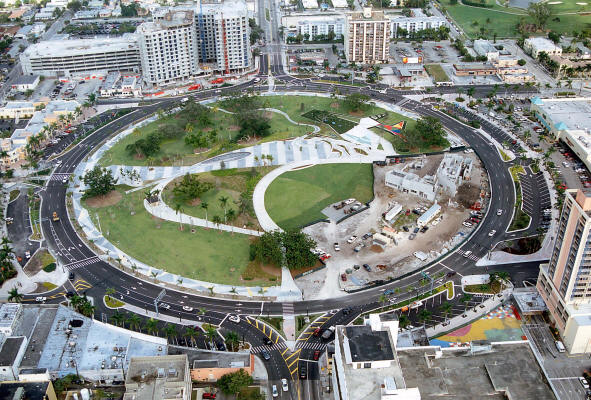
The thoughtless filling of Young Circle was completed with other non-native giants: figus and the royal poinciana. The figus has a luscious, dense green top and many trunks that can reach 30 feet across. The muscular branches of the royal poinciana reach out like static worms and shower the eye with scarlet color in the summer. These giant trees, planted from the 1920 to the 1960s, plus native sabal palms and vast diversity of evergreen scrubs and groundcovers, are the palette of the Florida retirement look. It is now being lost.
After the crushing hurricanes of 2004 & 2005, especially Wilma, the cities and counties are encouraging native and other trees that might have better hurricane resistance. The luscious green view with it annual energized flowering will be replaced with a gray-green stability more common in Houston or Savannah. Strangely, Glavovic Nothard allowed the invading Live Oak to be planted in the park. Perhaps, 12 months after Wilma, she had no choice.
Glavovic Nothard stated in her public tour of the park on March 17, 2007, that after she decided to make the vast shallow hill, the hill had to be carefully modified to preserve the original ground level at the base of the trees. Only two trees were transplanted.
Looking around it becomes clear that the park is an encounter with these trees. A bridge spans the roots of the double baobabs guarding the park's entry from the south. Like all great bridges, it invents a movement of passage. Instead of the view down the river, it celebrates the trunks and speckled shade. People stop and sit. Stand and view. As is frequent in Glavovic Nothard's design, the zone is both passage and place.
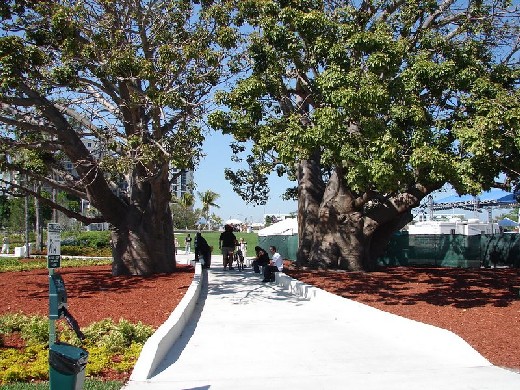
In the northwest quadrant, the trees make a zone of shaded grass. This zone existed before, but very few people ever used it. Glavovic Nothard's design guides people on narrow ribbon paths or wide river walkways to be near, but not touching, the trees. This distancing allows each tree to have its own space that overlooks the path. A rhythm develops of people partnering with each tree shade space. One tree, one family.
I don't know the artistic interaction of Taho and Glavovic Nothard, but the marriage is seamless. Not because of visual consistency, but due to the conceptual grounding of the park in the rhythm of tree and path. Taho's work is the poetic consolidation of Glavovic Nothard's plan. In my mind, this is the perfect collaboration sought for 25 years since the first artist-architect collaboration in contemporary public art: Viewland Hoffman Electrical Substation, Seattle, 1979.
Taho's "Millennium Springs" centers around the largest baobab and transforms its "biorhythm" into visual motion and sound. From the published information, I could not understand what she "recorded" in the tree. Intensity of electromagnetic waves? If os, what causes them? Does a healthy tree have a different pattern from a sick one? What about dry seasons and wet seasons? All interesting questions left unanswered.
With all artworks, we must release ourselves into the believable imaginary world of the artwork. Given that science is our verifier of truth, Taho's scientific measurement of the biorhythm pushes me over the tipping point into the believability. Even with the science, the "suspension of disbelief" will only function for those that have already let themselves feel the powerful forces in plants, so obvious in the spring.
Taho draws the dream pattern of Hollywood founder, Joseph Young, emanating from his bronze head. Here the dream pattern is a "typical" REM sleep wave. Although lovely in the concrete with the little shells, I find the ground drawing an uninspired narrative that is so frequent in public art today. I cannot find any imaginary world to enter. Just an idea that Mr. Young had a dream. Unfortunately for him, a dream that drove him into bankruptcy.
With the baobab, Taho constructs a multiplicity of senses and images that let my mind and body wander across her imagination. The biorhythms are remade in two forms: 1. sounds of "new age" slowly blending tones that equally surround the tree. 2. a moving graph of water made by 72 feet of computer controlled water jets. Both the tones and water merge with the two other dominate wave-patterned sounds: automobile engineers and wind in the leaves. For a work to be convincing, it must merge with the reality of the place.
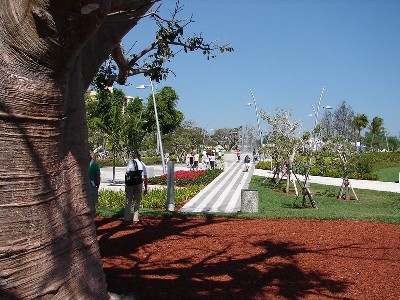
In her drawing, Taho's site plan looks like a string instrument with the tree as the sound chamber, the fountain as the tuning keys and a concrete path as the strings. On the ground, the concrete path has the same four white spaces as the "staff" on sheet music. In perspective from the tree, the water jets appear like musical notes running up and down the staff. Music with song and dance is the way we humans know the rhythm of ourselves and then the rhythms of the others like the tree.
(The City of Hollywood should invite Ellen Fullman, inventor the long string instrument, to play the space. That might over do it)
Regarding the fountain, most computer-controlled fountains have big breaks and total change: No water. All water. Every third jet. A mathematical run. Taho's pattern is like a slow wave. More like watching the ocean or a stream. Calming with predictable fluctuations. It is the pattern of a healthy biology, and therefore hopeful.
None of Taho's work is possible without Glavovic Nothard. Even Taho's final elegant touch, a Japanese ceremonial rope tied high around the trunk, requires Glavovic Nothard's equally clearheaded knowledge of the value of these trees and how to make space for each one. The shallow hill provides the effortless manner to make an object of the fountain. The fountain is placed as the final event "on the way" to the top of the hill. Like FL Wright, Glavovic Nothard imbeds the visual elements and places in crest of the hill and then leaves the top for the wind and the sky.
This brings us back to how nature contributes to Glavovic Nothard's local globalism. The main gathering place is the top of the hill because we must have breeze to gather together. The amphitheater seating faces the winds from the southeast and cuts the edge off the early evening sun during the concerts. The nearly complete arts center runs the central breezeway east-west because the length of outdoor hall blocks the hot rays of the east and west sun.
These are the details of place. So hard to communicate internationally. So hard to know without years living and observing in the same geography. So valuable for the bodily connecting to the earth in our time of exciting virtual exploration.
Just a Quickie
Check out the brutal assault on Fred Kent and the Project of Public Spaces (PPS) in the March issue of Landscape Architecture. The magazine opens with a generic panning of his method in the articles section by Linda McIntyre then concludes with the assault by Laurie Olin in the Critic at Large. Very rare thing in professional circles. The landscape architects are completely frustrated by Kent's insulting language regarding visual joy in public spaces and his empty methodology resulting in preconceived solutions from supposed conceptually open citizen workshops. I thought I was reading architects commenting on new urbanists.
I do not understand why PPS and so many new urbanists are afraid of visual pleasure. They seek out the bad designs in a modern vocabulary and ignore the best. Or sometimes they condemn excellent modern spacemaking without even really looking at the way people are using space. Like so many others on most sides of this false fence, they overlay words on images that are either untrue or applicable to a thousand other images in different styles. But the separation of design principle and style will not be revealed to the public.
The introductory paragraphs for the McIntyre article is at Landscape Architecture. Unfortunately, the magazine is resisting full publication on the web. You can read the completing interpretation of Bryant Park by the Olin Partnership and PPS
Landscape Architecture magazine is the BEST public art magazine in the world. All public artists should subscribe and many urban designers.
What do architects bring to the urban landscape? Primarily ignorance of all the rules. At least the best do.
In the other Hollywood, north of Miami Beach, Margi Glavovic Nothard's Young Circle Arts Park opened on March 16, 2007. I wish she could upstage Weiss / Manfredi's Olympic Sculpture Park the way that Gehry's Guggenheim at Bilbao pushed Meier's Getty to the back seat. But like Bilbao, the Seattle park has a tight dramatic setting that is impossible competition for just another flat place in Florida.
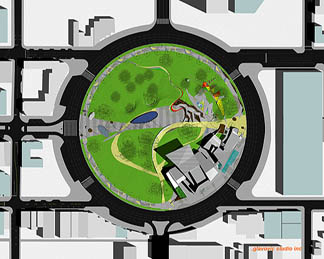
Glavovic Nothard is my friend and I wrote the original grant in 2001 that secured $5 million in funding from Broward County for the park. No professional reason existed for her to design the park except other tenacious women had faith in her, especially Cynthia Bergman Miller (former director of the Hollywood Arts and Culture Center) and Mara Giulianti, Mayor of Hollywood. The park might be the first all female produced civic landmark in the same "natural" way that powerful men have enjoyed a free hand for so long.
When Glavovic Nothard started the process, her inexperience with park design showed. (Not urbanism where she is an expert.) She gathered images from everywhere trying to imagine all the kinds of spaces and events that needed to exist. These images were patterns like Christopher Alexander with his sense of the personal experience except with her modern eye that loved shape, color and play. She even managed to bring energy back to images used thoughtlessly by tired Florida landscape architects.
The problem with the Alexander pattern method is the unity. She resolves through a "matter of fact" urbanism, a hill and an extensive knowledge of hot climates (Born and educated in South Africa and practiced in southern California and Florida). The main plaza / pathway links to the pedestrian downtown and the children's area is closest to the single-family neighborhood. Every massive tree was saved and carefully understood for its character and space making.
Her finest act was to create a hill on the entirely flat park. In southern Florida, people are very sensitive to minor elevation changes, so the eight to ten feet makes the park unique and helps to subdivide the park into zones. MOST IMPORTANTLY, when you see the photos at the Aesthetic Grounds Visual Essays page, all the elevation difference is her design. In the future, everyone will assume that the hill is a natural situation and ignore her intelligence in the choice.
I can't finish this today. Too much time on the photographs. But I will return to discuss the park and the artist, Ritsuko Taho.
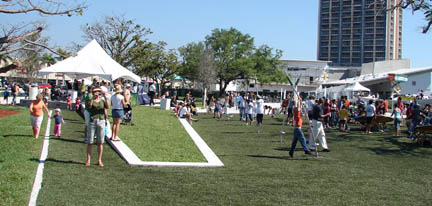
For the architectural historian, let me throw out something as you look at the photographs: Aldo van Eyck's ghost smiles over the park. Maybe it's a crossing of intelligences by African intensely interested in the Dutch and a Dutchman intensely interested in Africa. Glavovic Nothard and Van Eyck share the ability to make a multitude of places on a single plane by drawing small territories on the ground through material or shadow. The joyous cries of children on the opening day demonstrate that both believe that children's imaginations respond to abstract space and form at their own scale. Formally, they try the impossible: to make pathways dividers and places at the same moment. Most literally, the shallow hill enlarged by Glavovic Nothard is one of Van Eyck most famous drawings. Of course the works look nothing like each other and Glavovic Nothard contemporary spatial flow replaces Van Eyck's modernist cartesian rhythm, but still..............
Continue later.
You can visit the City of Hollywood website and see a panorama photo of the 2001 flat park.
In the mid-1990s, I visited a scary Johannesburg. The hotel had non-uniformed armed guards carrying guns. Drug dealers were on hand. Unlike other parts of South Africa, everyone spoke of the dangers after dark. Yet, art went on. I can see in my memory a black man and a white man playing tennis inside the main dining room of Jo'burg's abandoned historic prison. During the performance, the men talked of their different lives and their confrontations.
At the same moment, whites and blacks admitted to terrible murders as part of Bishop Tutu's and Nelson Mandela's "Truth and Reconciliation" process. With several hundred South Africans, I spent two days in the meeting hall of Port Elizabeth listening to confessions of killings. Was the art in the prison or the hall? For the outsider, especially one that grew-up in the socially segregated southern USA, both were emotionally vibrant.
In 2006, Jo'burg passed a public art ordinance that is 100% American vanilla. In the preamble: "...Public Art provides a means of celebrating Johannesburg's unique culture, diverse communities and rich history. It offers shared symbols which build social cohesion, contribute to civic pride and help forge a positive identity for the city." In just ten years has the passion so drained from life? Or was life so full of the tensions of art, that art was asked to become a generic warm blanket?
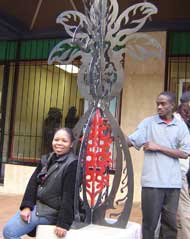
The first official public art was unveiled in July 06 with nine steel trees on Juta Street created through a collaboration of students and artist Claire Regnard. According to the City website, the works cost only $10,000 as apart of a $1.3 million cultural enhancement before the 2010 World Cup finals in Johannesburg.
Like the public art ordinance, these sculptures are the type that give public art a bad name amoung the museum world. They are almost powerless artistically, yet justified administratively by collaboration with children and by populist colors. Equally empty is the simplistic anti-AIDS mural by artists Tshepo Mofokeng and Mandla Manana that was the second public art project. (Strangely, none of the articles on the project make reference to Baobab trees so obviously reflected in the sculptures proportions of fat trunk to branches. The bright centers recall the reality and mythology of the life (80% water) in the heart of the massive trunks.)
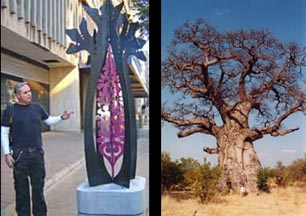
Both are typical kinds of projects to engage the community at the beginning of a new program where everyone - artist, community and politicians - is paying attension. But after the intensity of the life and art in the 1990s, the absence of social confrontation or emotional stress is shocking. Like many American programs, I can only understand this as repression, but through absence rather than action.
(I hope Johannesburg will forgive me for assaulting a number of timid American public art programs via Jo'burg's first official projects. Visit Visual Essays for More Photographs)
Cascoland Festival, Johannesburg, March 2007
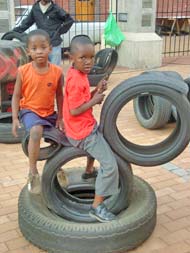
Tire Art by Jan Korbes
Unrelated to the official public art is the second Cascoland Festival, a weeklong collaboration of all art forms between residents surrounding Drill Hall and artists from the Netherlands and South Africa. The public art is very architectural and hands-on, so typical of liberal Dutch artists during the last 20 years. Everything is nomadic - tents, plastic pools, streets games, tires - in which the art is the placement. In Drill Hall, the tents landed on the roof and the pool crashed into the basement.
The first Cascoland Festival in Capetown had more imported high art, Dutch style. Projects include daily life in a pristine white bubble, a star bath in the plaza, a radio broadcast speaker tower and self-stenciled houses.
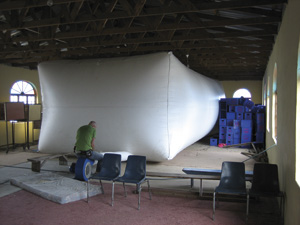
Art Installation by Bert Kramera
Clarifications sparked by a question from Regina Hacket of Seattle.
Why is the relationship between architecture and visual art so persistent in Argentineans? Clorindo Testa may be the most successful visual art and architect to live since Le Corbusier. Visual artist Guillermo Kuitca's paintings breathe in the dark space of the theater. As a public artwork, Kuitca interpreted the DPZ site plan for Miami's Aqua Development in 2005. Emilio Ambasz haunts in imaginary world between poet, earth artist and architect. From Uruguay, but raised and educated as an architect in Buenos Aires, Volf Roitman recently completed the MADI Museum in Texas. Cesar Pelli provides the space for art to sing at least since the celebrated public art at his Battery Park City in the 1980s and recently at the 2006 Carnival Performing Arts Center in Miami. University of Miami architecture professor, Roberto Behar with his partner Rosario Marquardt, continue to produce some of best permanent and temporary urban interjections in the world.
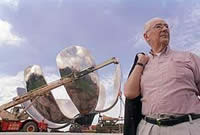
Researching the Flower of Buenos Aires, another Argentine architect - Eduardo Catalano - emerges as the artist. And not just any architect, but yet another designer sparked to artistic complexity by Walter Gropius. Catalano completed his architectural studies at Harvard in 1945 and later move to the USA in 1950 to join an amazing faculty at North Carolina State University that included Buckminster Fuller, Matthew Nowicki and Lewis Mumford. The hyperbolic parabaloid roof of his 1954 home was a product of this creative environment. Unfortunately, the house was demolished in 2001 like so many tiny masterpieces of modernism by underrecognized architects around the USA.
He moved on MIT with the brilliant Pietro Belluschi another underrecognized master that HAS achieved protection for his work in the Pacific Northwest. Together, they designed Julliard School of Music and Alice Tully Hall in NYC now under renovation by Diller Scofido + Renfro (Another creative team of the artist / architect variety).
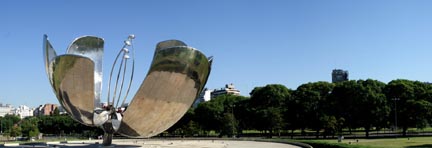
So at 82 years old in 2002, Catalano designs, produces and installs the sculpture, "Floralis Genérica", behind the National Museum of Fine Arts in Buenos Aires. (Testa, now 84 himself, continues to produce exhibitions of paintings and sculptures) The flower is no simple construction for all its simplicity of form. The 18 tons of aluminum and stainless steel was manufactured by Lockheed Martin Aircraft Argentina. Through hydraulic mechanics, the 13-meter tall pedals move to open and close in the morning and evening each day. Fully open, the flower spans nearly half a football field at 40 meters in diameter. Closed the sculpture is 20 meters high.
Unlike Anish Kapoor's 2005 "Cloud Gate" in Chicago, the art is lonely. (Type "Floralis Genérica, Buenos Aires" into Google Earth for the site and variety of photos.) In a city swarming with 12 million people, the Plaza of the United Nations is empty and cut off from the city by wide rivers of traffic. Unlike Cloud Gate that absorbs architectural Chicago in the polished surfaces, Floralis Genérica (Generic Flower) reflects a generic green landscape and gray or blue skies that could be anywhere. Cloud Gate pulls the visitor to an intimate play with images of self and city. Floralis Genérica pushes the visitor to view the full sculpture and engages the visitor in a psychological conflict between pop icon and subtle observation of every surface. Cloud Gates elevated plaza accentuates its importance and place, while Floralis Genérica struggles in nowhere. The flower should be the winner in the contest of icon making, but the bean's 360-degree crisp image of the city has the photographic clarity lost in the flower. Location, location, capture the location.
The sculpture is located at the Plaza Naciones Unidas at the intersection of Figueroa Alcorta y Tagle near the Recoleta Cultural Complex.
Cloud Gate is 30 meters long and 10 meters high. Floralis Genérica is 40 meters in diameter and 20 meter high. Cloud Gate cost $23 million. Floralis Genérica rumored to cost $4.5-6 million as a private donation by Catalano himself.
As a new item, I will add video from various sources on public art and public space. The first is a 100% repetitive report from the local FOX evening news in Tampa, Florida. If you have seen one, you have seen them all. The story starts with the "CONTROVERSY" at the public building.
1. Government spends too much on art
2. Something is strange about the artwork
3. Interview someone that likes it
4. Interview someone that thinks it's a waste of tax payers dollars.
5. Interview someone from government that says it's a response to the community by a very talented artist
6. Repeat the cost. Repeat the cost.
7. Fade out with "local politicians want to examine reducing or eliminating the excessive amount of money on art"
In this video, the artist Audrey Flack is presented as a professional.
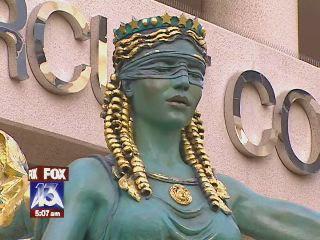
Below is the text story from FOX. This link is to the full FOX video.
TAMPA - Beauty may be in the eye of the beholder, but it looks a little different when it's paid for with tax dollars.Just ask some angry Hillsborough County citizens. They're upset about a controversial new statue in front of the Tampa's Edgecomb Courthouse.
'Lady Justice' is 15 feet high, weighing 3,000 pounds--and it cost $400,000 to build.
She's just been put up in front of the courthouse, and she's already got people talking.
"I think it's a great piece of art," said Deputy Ricardo Alves of the Hillsborough County Sheriff's Office. "It reminds me of the Statue of Liberty almost."
The brand-new statue is green bronze with real gold leaf. She's blindfolded--to show blind justice.
The artist who created her says she's supposed to soothe the people going to court.
"People are going to come to the courthouse probably in deep angst," said Audrey Flack, who is responsible for the creation. "You know, 'Am I going to get put in jail? Am I going to lose my house?' People are going to talk to this, I believe."
But some disagree. In fact, some people are irate over what 'Lady Justice' cost the county.
"I'm a taxpayer so I think they could have used that money more wisely-- on the schools, on roads, on anything other than a statue," said David Finch, a resident of Hillsborough County.
County taxes and court fees paid for the statue, and it is to date the most expensive piece of public art the county has ever purchased.
"It is expensive, but on the other hand, great art is expensive," said Bill Iverson, Hillsborough County's public art manager.
Administrators say they had no choice about how much to spend. A county law says one percent of the total cost of a public project like the Edgecomb Courthouse must go to public art.
The county's public art commission chose Flack as the artist, and they say they're glad the statue I generating conversation--and controversy.
"We consider ourselves a museum without walls," said Iverson. "A place where people can come experience great art without having to pay an admission fee."
Flack says she believes 'Lady Justice' will bring life and money back to downtown Tampa.
"Look, would you go traveling to an industrial city, or would you go to Florence? You're going go to Florence to see Michelangelo's David," she said.
County commissioners have already asked a team to work on changes to the current ordinance that puts money toward public art. They want to reduce the amount of funding that must accompany public construction.
I admit it. I have looked down on arts and crafts street fairs as a kind of subspecies of the artworld. The fairs are fully acceptable as cultural phenomena if composed of truly local makers, especially with ethnic or migrant identity. But not acceptable as a place for the educated artist as was defined historically in the 20th century by New York museums and galleries.
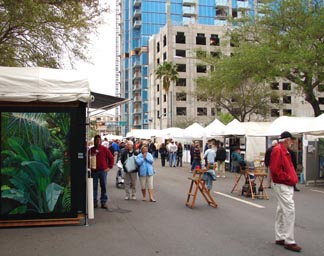
Images from Gasparilla Festival of the Arts, Tampa, Florida, March 3 & 4, 2007
Yet every winter weekend in Florida, an arts festival of talented artists fills the downtown, central streets and parks of several towns. In the state, only downtown Miami has no significant event. Some draw hundreds of thousands of people filling the streets, bars and restaurants to capacity.
As placemaking, the arts festival replaces the automobile with crowds between repetitive white, 10 x 10 x 8 tents. Inside the narrow zone, the eye of the walker or shopper is contained until the abrupt end of the row. Only the wind, sun or rain give any geography as the surrounding city is ignored. You are not "anywhere", but you need to look up occasionally to remind yourself where you are.
The street fair does bring new sights on the city or park. Walkers turn and orient themselves from the less experienced locations in the center of the streets or "off the grass" park zones. Views of buildings emerge. Traffic islands are places, not dividers. A sense of enclosure is felt in center of the street that cannot be known on the typical edges with the moving cars in the middle. New self-initiated paths emerge across green and asphalt.
The view of the artist is a different view unknown to the tens of thousands of visitors. The artists learn the street intimately- its pitch, its potholes, its grease, its trash. Setting up at night, the artist leans psychologically and physically toward the dim electric bulbs of the streets or buildings. During the rain, the success or failure of the gutter brings relief or panic. The returning sun washes out colors or converts the artworks to dark silhouettes against the translucent plastic walls.
In general, the artists believe that sitting in the tent keeps the customer away, an attitude completely opposite of every other "in your face" pedestrian street market in the world. On closer observation, the larger the object, the more the artist disappears. Makers of jewelry assist all the lookers. Potters and glass blowers sit among their work. Painters peak out from behind a tent opening and only meet the people when approached and asked, "Are you the artist?" The difference seems related in part to theft as the painters of 10 x 6 canvases just abandon their tents completely after the judging for "best in show."
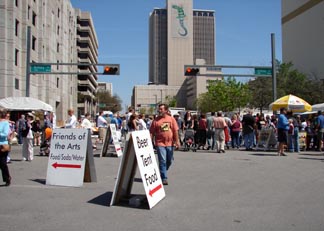
As the thousands pass each hour, only a tiny few stop to look at any one tent. The larger the artwork, the less the visitors. This axiom is a function of purchasing power of the customers and the standardization of the tent in which all the large works can be seen from the street.
Regarding the view down my nose, these artists are artists and quite a special breed. They travel from their homes in the eastern half of the USA to live out of a van for 8-12 weeks in January, February and March. They come to SELL their work. Each show is crapshoot that might mean nothing or thousands of dollars. Being seen is regular stuff. Sales make the difference.
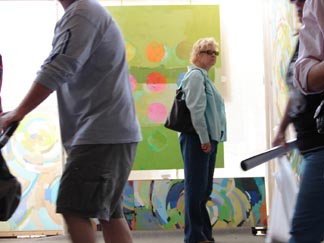
Artwork of Maria Foladori Weiss
Unlike those artworld artists, they are empowered. Yet they carry a kind of benign pessimism based in the economic reality of their lives.
These artists don't wait to be discovered by a curator or picked up by a gallery. They act. They develop a direct relationship with their customers that can also become their collectors. They completely control the presentation of their work. And unlike the artworld artists - many of these artists might be seen by more than a million art-loving people a year.
At the end of the day, the 20th century artworld holds its trump card - the art is not art. If the artworld thinks so, then it is because they don't go EVERY gallery in NYC each month to be drowned by the repetition of forms and because they don't look at the art in the art festivals.
In the major Florida festivals, the artists are artists. Intense examination reveals the excellence in color, composition, materials and storytelling. Yes these artworks are not part of the contemporary artworld dialogue and therefore will not be a part of that conversation. Yes these artworks are not of the moment and could have been appreciated by different artlovers 20 years ago. Taking the long view - global warming and all - does that really matter beyond the momentary fun of the art conversation? These artists are tough and skilled.
I was proud to be among these artists as my wife attempted to directly find an audience and buyers for her paintings.
One of the best things about writing on Public Art and Public Space is the lack definitions. The field has no rules as to what is aesthetically successful. No rules on what kind of creations are included. No rules on which art centers get to officially generate the new and interesting.
As my wife and I have attempted to sell my wife's painting at an arts festival this weekend, I leave to you the Switch on London project. The work is by lighting designers and focuses on the lack of pure color in our world. Some of the designers are creating guerilla light art which is made successful by selection of site. It reminds me the growing field of creative people using light to make installation. Lights On Tampa was a huge success according to the Public Art Network that included nearly every project in its 2006 Best of American Public Art. Lighting designers like Linnaea Tillett have been collaborating. A long list of public artists from Thomas Heatherwick to Leni Schwendinger have made an art of public projects using light.
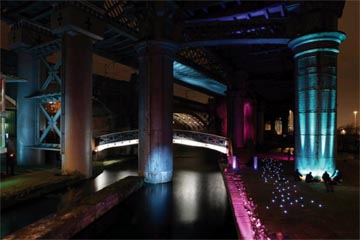
Visit the Switch on London and check out the "project" tab. Under the "lighting designers" tab are links to each designer with more examples of contemporary technology.
On March 1, 2007, the City of Miami Beach establishes the 6th, 7th, or ? arts district in the Miami Metro Area. CANDO, Cultural Arts Neighborhood District Overlay, is centered on the Convention Center, home of Arts Basel. Other institutions include: New World Symphony, Bass Museum, Miami City Ballet, Jackie Gleason Theater, the Miami Beach Botanical Garden and Art Center South Florida. Lincoln Road is the main social space with cafes, artworks and smaller performances.
Miami Metro is sprouting arts districts in the 21st Century: North Miami with MOCA, Design District, Wynwood, Carnival Performing Arts Center and with a lot of luck, Homestead. They join Coral Gables and Coconut Grove. Soon the Art Museum District. This is fueled by private collectors, international buyers of art and the need to produce quality street life activity to support the vast, vast quantity of high end residential development.
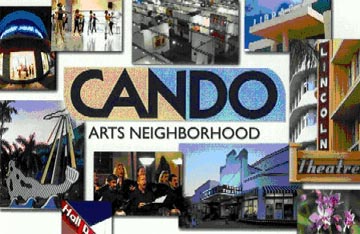
Just as the lush landscape, golf and sunshine sparked the suburban residential development from 1960-1995, now the arts lead the reinvestment. Active streetscapes, urban grazing and nightlife are the new key aesthetic features replacing nature.
Blogroll
AJ Ads
AJ Blogs
AJBlogCentral | rssculture
Terry Teachout on the arts in New York City
Andrew Taylor on the business of arts & culture
rock culture approximately
Laura Collins-Hughes on arts, culture and coverage
Richard Kessler on arts education
Douglas McLennan's blog
Dalouge Smith advocates for the Arts
Art from the American Outback
For immediate release: the arts are marketable
No genre is the new genre
David Jays on theatre and dance
Paul Levy measures the Angles
Judith H. Dobrzynski on Culture
John Rockwell on the arts
Jan Herman - arts, media & culture with 'tude
dance
Apollinaire Scherr talks about dance
Tobi Tobias on dance et al...
jazz
Howard Mandel's freelance Urban Improvisation
Focus on New Orleans. Jazz and Other Sounds
Doug Ramsey on Jazz and other matters...
media
Jeff Weinstein's Cultural Mixology
Martha Bayles on Film...
classical music
Fresh ideas on building arts communities
Greg Sandow performs a book-in-progress
Exploring Orchestras w/ Henry Fogel
Harvey Sachs on music, and various digressions
Bruce Brubaker on all things Piano
Kyle Gann on music after the fact
Greg Sandow on the future of Classical Music
Norman Lebrecht on Shifting Sound Worlds
publishing
Jerome Weeks on Books
Scott McLemee on books, ideas & trash-culture ephemera
theatre
Wendy Rosenfield: covering drama, onstage and off
Chloe Veltman on how culture will save the world
visual
Public Art, Public Space
Regina Hackett takes her Art To Go
John Perreault's art diary
Lee Rosenbaum's Cultural Commentary
Tyler Green's modern & contemporary art blog
